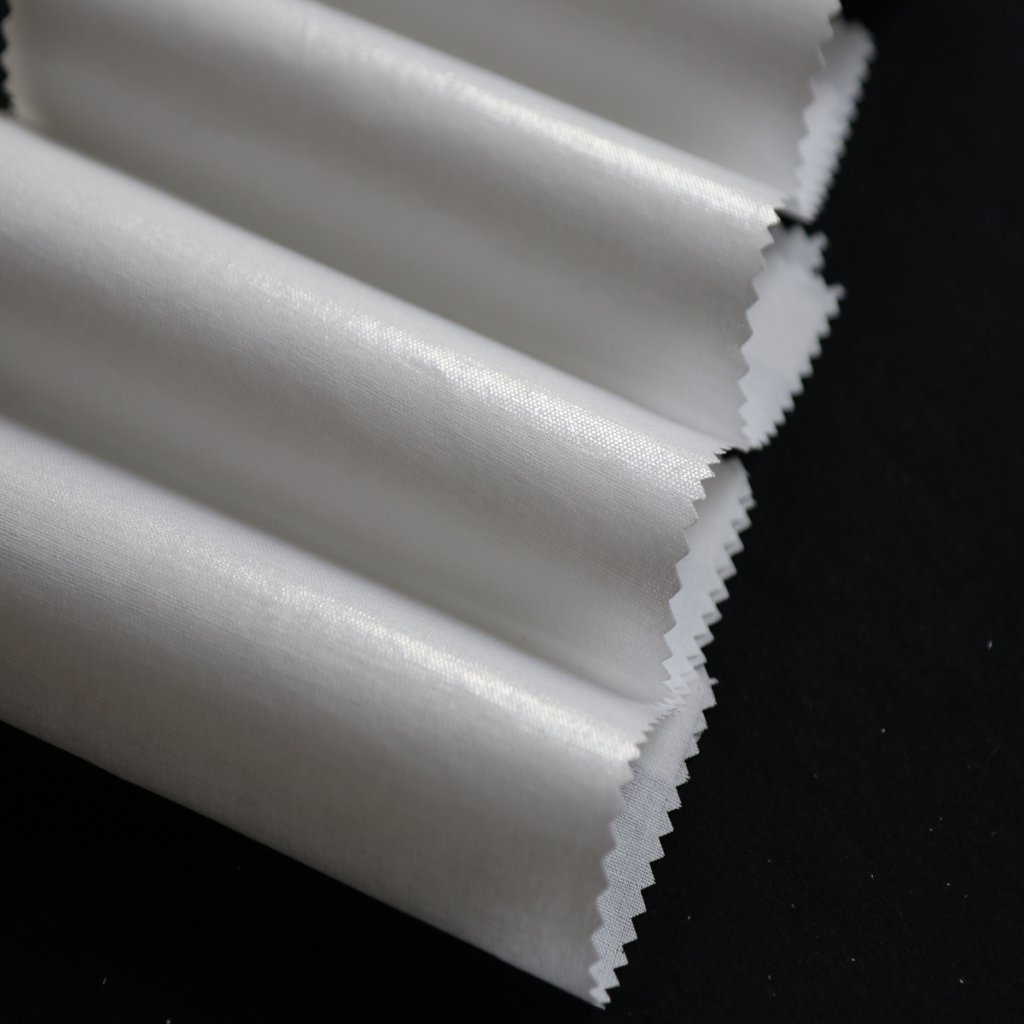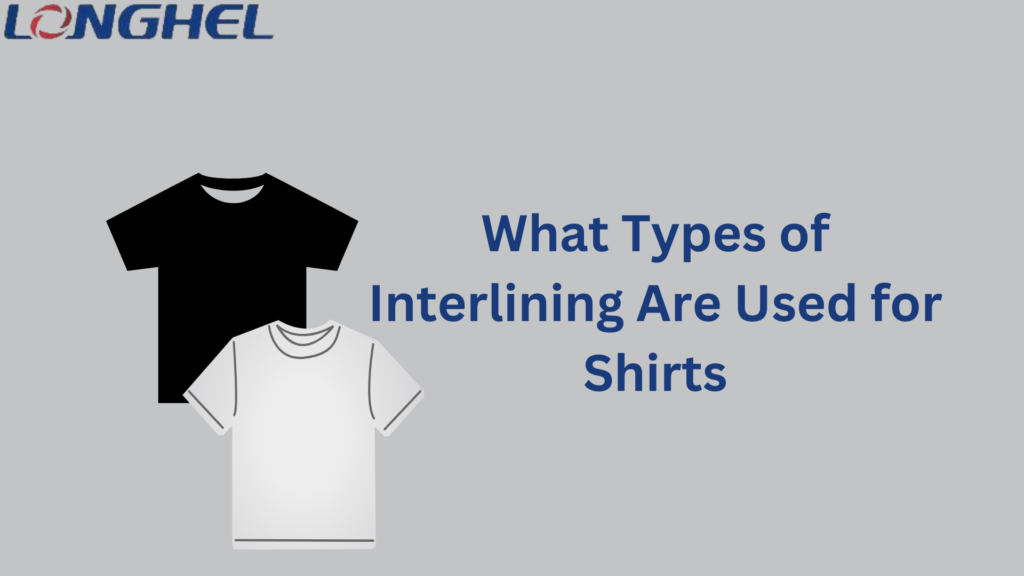Introduction
Interlining is a key material used in making shirts. It is a layer of fabric between the outer and inner lining. Its main job is to give shape, support, and structure. You often find interlining in collars, cuffs, plackets, and yokes.
Interlining helps shirts keep their shape, last longer, and look polished. There are different types, each serving a specific purpose. The type you choose affects how the shirt looks and feels.
Casual shirts might need softer Interlining, while formal shirts often need stiffer options for a crisp look. Interlining can be grouped by how it bonds to the fabric, material, and weight. Picking the right one makes a big difference in quality.
This guide will explain the types of interlining used in shirts. You’ll learn how each works and what to consider when choosing the best. Understanding Interlining is important, whether for casual or formal shirts. It makes all the difference in how a shirt fits, feels, and lasts.
What Are the Different Types of Interlining Used for Shirts?
Interlining comes in different types, each with a unique purpose. Choosing the right one can change how a shirt looks, feels, and wears over time. Interlining is mainly classified by structure, material composition, and weight.
How does structure classify Interlining?
Interlining is classified into two main types based on structure: fusible and non-fusible.
- Fusible Interlining has an adhesive coating on one side. It bonds to the fabric when heat and pressure are applied. This makes it easy to use and helps create a smooth, strong finish. It is widely used for shirt collars, cuffs, and plackets.
- Non-fusible Interlining has no adhesive layer and is sewn directly into the fabric. It is softer and more flexible and works well for delicate fabrics that cannot handle heat. Non-fusible Interlining is often used for high-end and tailored shirts.

How does Material Composition classify Interlining?
Interlining can also be grouped by its material type.
- Woven interlining is made by weaving fibres together. It is strong and stable, and this type is used for stiff collars and cuffs.
- Bonding fibres make non-woven Interlining without weaving. It is lightweight and affordable. It works well for casual shirts.
- Knitted Interlining is flexible and stretchy. It is often used for fitted shirts or styles that need more movement.
How does weight classify Interlining?
Interlining comes in three main weights: lightweight, medium-weight, and heavyweight.
- Lightweight Interlining is best for dress shirts. It adds subtle support without stiffness.
- Medium-weight Interlining is used for casual or semi-formal shirts. It balances structure and flexibility.
- Heavyweight interlining provides firm support. It is used for formal shirts to give a crisp, structured look.
Where Is Interlining Commonly Used in Shirts?
Interlining is essential in specific parts of a shirt to add structure, strength, and a polished finish. It plays a key role in areas that require stability and shape retention, such as the collar, cuffs, front placket, and yoke.
Why Is Collar Interlining Important?
Collar interlining helps a shirt collar keep its shape and structure. Without it, collars can become floppy and lose their crisp appearance. The type of Interlining used determines whether the collar feels soft or stiff.
Formal shirts often have firmer Interlining for a sharp look, while casual shirts may use softer Interlining for a relaxed feel. Collar interlining ensures the collar stands correctly and gives a professional look.
How Does Interlining Enhance Cuffs?
Interlining in cuffs keeps them firm and prevents them from sagging or wrinkling. It adds structure and helps the cuffs maintain shape after washing and wearing. The right type of Interlining makes cuffs look clean, polished, and long-lasting. Different shirts may use softer or stiffer Interlining based on their style and intended use.
What Role Does Interlining Play in Front Plackets?
The front placket is where buttons and buttonholes are located. Interlining in this area provides extra strength and prevents sagging. It ensures the placket stays flat and maintains a neat, structured appearance. Properly interlined plackets offer durability and prevent distortion from daily use.
How Is Interlining Used in Yoke and Shoulder Support?
Interlining in the yoke and shoulder areas improves a shirt’s fit and stability. It prevents these areas from sagging and helps the shirt maintain its intended shape. Interlining in these areas is particularly important for tailored shirts, as it enhances their structure and provides a better fit across the shoulders.

How Do You Choose the Right Interlining for Shirts?
Choosing the right Interlining is crucial for creating high-quality shirts. The right Interlining improves the shirt’s fit, structure, and durability. When selecting interlining, it is important to consider fabric compatibility and the shirt’s intended use.
What Should You Consider for Fabric Compatibility?
The fabric of the shirt plays a major role in selecting Interlining. Delicate fabrics like silk or lightweight cotton need soft or non-fusible Interlining. This prevents damage caused by heat or adhesives used in fusible Interlining. On the other hand, sturdy fabrics like thick cotton or linen can handle fusible Interlining well.
You should also consider the fabric’s weight. Lightweight fabrics match best with lightweight Interlining to maintain a smooth and flexible feel. Use medium or heavyweight Interlining for heavier fabrics to provide proper support and maintain shape. Testing interlining on a fabric sample is a good way to ensure compatibility.
How Does the End Use of the Shirt Affect Interlining Choice?
The purpose of the shirt affects which interlining to use. Formal shirts often require stiffer Interlining for a sharp, structured look in collars and cuffs, which gives them a polished and professional appearance. Casual shirts benefit from softer Interlining, which provides comfort and flexibility.
Consider how often the shirt will be worn and washed. Shirts meant for daily wear need interlining that holds up over time. Choosing durable, quality interlining ensures the shirt keeps its shape and performs well.
Special features, like stretchable shirts, may need flexible Interlining like knitted types. For fitted styles, choosing Interlining that supports movement is key.
What Are the Latest Trends and Innovations in Shirt Interlining?
Interlining for shirts continues to evolve with new trends and innovations. These changes focus on making interlining more sustainable, comfortable, and effective. Two key trends include eco-friendly materials and advanced technologies that enhance performance.
What Is Eco-Friendly and Sustainable Interlining?
Sustainability is a major focus in the textile industry, including shirt interlining. Eco-friendly Interlining uses biodegradable and recycled materials. These options reduce the environmental impact of garment production. Some interlining products are made from organic cotton, plant-based fibres, or recycled polyester.
Sustainable Interlining often uses eco-friendly adhesives with less harmful chemicals, helping reduce the carbon footprint of shirt production. As consumers become more aware of how their clothing choices affect the environment, brands are increasingly using sustainable Interlining to meet demand and support ethical practices.
What Are the Technological Advancements in Interlining?
Technology is reshaping and interlining with innovations. Smart Interlining is one example. It offers features like moisture-wicking, temperature control, and odour resistance. This type of Interlining improves comfort and performance, making shirts more functional for daily wear.
Adaptive Interlining is another development. It adjusts to the wearer’s shape, providing better fit and movement. This is especially useful for modern, fitted shirt designs.
Some advancements focus on lightweight, high-strength materials. These interlinings add structure without extra bulk, helping maintain the shirt’s shape while keeping it light and comfortable.
Manufacturers also use advanced bonding techniques to improve the durability of fusible Interlining. These techniques ensure a secure bond without damaging the fabric.

How Can You Select Quality Interlining for Shirts?
Choosing the right Interlining for shirts is essential to achieve the best structure, fit, and comfort. Quality interlining ensures a shirt keeps its shape, wears well, and looks great. To select the best option, consider the specifications and how well it performs.
What Should You Know About Interlining Specifications?
Understanding the specifications of Interlining helps you make the right choice. Key factors to consider include weight, thickness, adhesive type (for fusible Interlining), and breathability.
Lightweight Interlining works best for soft, delicate fabrics and casual shirts. Medium-weight interlining offers a balance of structure and flexibility, making it suitable for everyday shirts.
Heavyweight interlining provides firm support and is often used for collars and cuffs in formal shirts.
The type of adhesive used in fusible Interlining also matters. Some adhesives work better with certain fabrics, while others may cause stiffness. Check if the interlining offers good breathability to ensure comfort.
How Can You Test Interlining for Durability and Comfort?
Testing Interlining helps determine if it meets your quality standards. Start by bonding or sewing the Interlining to a fabric sample. Observe how it affects the fabric’s feel, structure, and drape.
Wash the sample multiple times to see if the Interlining holds up well. Check for signs of separation, wrinkling, or loss of structure. This will show how it performs during real use.
Evaluate comfort by feeling the fabric with the Interlining in place. Make sure it does not add unnecessary bulk or stiffness. Softness, flexibility, and support are key factors to test.
Conclusion
Choosing the right Interlining for shirts is important. It improves the shirt’s structure, durability, and look. Different types of Interlining serve different purposes. These include fusible, non-fusible, woven, non-woven, and knitted options. Interlining also varies by weight, from light to heavy.
Interlining adds shape and support to collars, cuffs, plackets, and shoulders. Picking the right Interlining makes shirts fit better, last longer, and look great.
Understanding interlining specifications helps you choose the best option. Today, new eco-friendly and advanced interlining options are available. These meet both style and performance needs. Interlining continues to improve, offering better results for shirtmakers.
Contact us today to get the best interlinings customized for your business.

